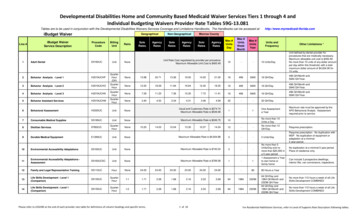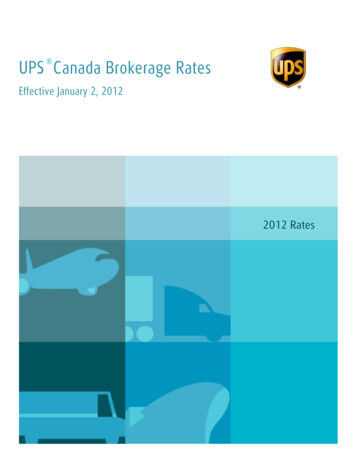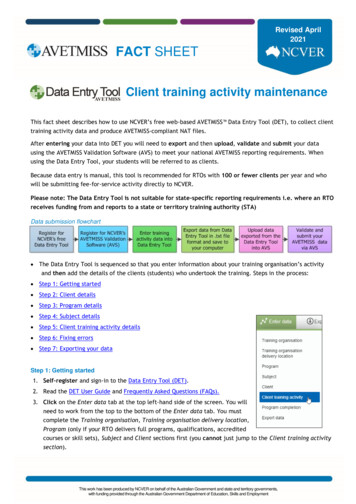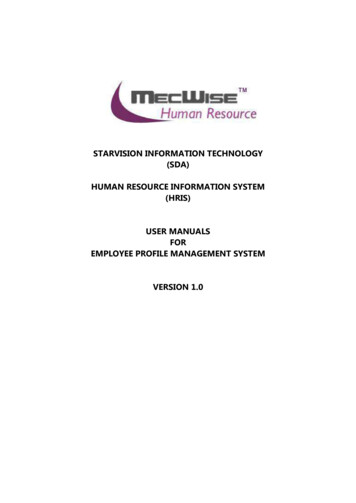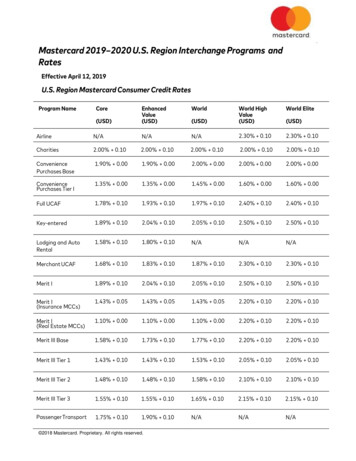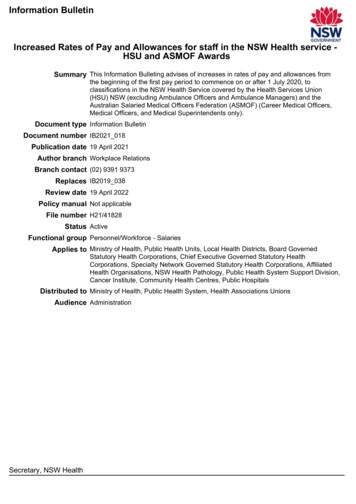
Transcription
The Federal Long Term Care Insurance Program 3.0bookoneProgram Details and Rates
This book, including the outline of coverage, is not an insurance contract,but a summary of certain information regarding the Federal Long Term CareInsurance Program (FLTCIP) coverage. Other rights are contained in thegroup policy that OPM has with us. If you apply for the coverage offeredunder the FLTCIP and your application is approved, you will automaticallyreceive a copy of the FLTCIP 3.0 Benefit Booklet. It is important that you readyour benefit booklet carefully! The FLTCIP 3.0 Benefit Booklet and the scheduleof benefits will contain the governing contractual provisions that relatespecifically to you. If any language or provisions here differ from the FLTCIP3.0 Benefit Booklet, the benefit booklet will be the controlling document.The following information applies to the FLTCIP 3.0 plan.
Table of ContentsEligibility2The Federal Long Term Care Insurance Program3Key features8Prepackaged plans10Customized plans11Options for paying premiums11Premiums12Qualifying for benefits16What is not covered by the FLTCIP16FLTCIP 3.0 Outline of Coverage17The Federal Long Term Care InsuranceProgram Privacy Notice40Note: Defined terms appear in bold at first usage. If a term is notdefined within this brochure, see the “Glossary” section in Book Two:Additional Information.Questions?Visit us at LTCFEDS.comor call us at 1-800-LTC-FEDS(1-800-582-3337) TTY 1-800-843-3557.The Federal Long Term Care Insurance Program issponsored by the U.S. Office of Personnel Management,insured by John Hancock Life & Health Insurance Company,under a group long term care insurance policy, andadministered by Long Term Care Partners, FEDS (1-800-582-3337)1
EligibilityFederal and U.S. Postal Service employees and annuitants, active and retired members of the uniformedservices, and their qualified relatives are eligible to apply for coverage under the Federal Long Term CareInsurance Program (FLTCIP). Specifically, persons in the following groups are eligible to apply for coverage:Employees Federal employees in positions that convey eligibility for the Federal Employees Health Benefits(FEHB) Program (whether or not they are actually enrolled) U.S. Postal Service (USPS) employees in positions that convey eligibility for the FEHB Program(whether or not they are actually enrolled) Active members of the uniformed services who are on active duty or full-time National Guard dutyfor more than 30 days, including: active members of the Selected Reserve (members of the Individual Ready Reserve are not eligibleto apply) Other eligible employees: Tennessee Valley Authority employees (even though they may not be eligible for FEHB coverage) D.C. Government employees who were first employed by the D.C. Government before October 1, 1987 D.C. Courts employees Commander, Navy Installations Command (CNIC) employees Nonappropriated Fund (NAF) employeesAnnuitants2 Federal or USPS annuitants Retired members of the uniformed services who are entitled to retired or retainer pay, including: retired grey reservists, even if they are not yet receiving their retired pay Other eligible annuitants: deferred annuitants separated employees with title to a deferred annuity, even if they are not yet receiving that annuity Tennessee Valley Authority annuitants compensationers receiving compensation from the U.S. Department of Labor D.C. Government annuitants who were first employed by the D.C. Government before October 1, 1987 D.C. Courts annuitants CNIC annuitants NAF annuitants Surviving spouses receiving a survivor annuity and domestic partners of deceased workforcemembers receiving an insurable interest annuity (visit LTCFEDS.com/eligibility to determineif you are eligible as a survivor)Qualified relativesIf you are a qualified relative as described below, you can apply even if the person you’re related to doesnot apply, or even if the person you’re related to applies but is not approved for coverage. Current spouses of eligible employees Current spouses of eligible annuitants (but not former spouses, even if they are receiving anapportionment of annuity) Parents, parents-in-law, and stepparents of living eligible employees (parents, parents-in-law, andstepparents of annuitants are not eligible)TheFederalFederal LongLong TermTermCareCareInsuranceInsurance ProgramProgramThe
EligibilityQualified relatives (continued) Adult children (at least 18 years old, including adopted and stepchildren) of living eligible employeesand annuitants Domestic partners* of eligible employees and annuitants (visit LTCFEDS.com/eligibility to determineif you are eligible as a domestic partner)*A Declaration of Domestic Partnership form must be submitted to the employee’s agency or annuitant’sretirement system before you apply. Visit LTCFEDS.com/eligibility for details.The Federal Long Term Care Insurance ProgramLong term care insurance may be a smart way to protect your income and assets and remain financiallyindependent should you need long term care services at home, in a nursing home or an assisted livingfacility, or in other settings. In general, traditional health insurance plans—including TRICARE For Life orMedicare—do not pay for the chronic, ongoing assistance with daily living that is most often associated withlong term care. And long term care services can be very expensive. These are the current national averagesfor long term care services1: 24 an hour for a home health aide 72 a day for care in an adult day care center 4,725 a month for care in an assisted living facility 254 a day for a semiprivate room in a nursing home 289 a day for a private room in a nursing homeHome care—which most people prefer—is generally more affordable than nursing home care but still canbe expensive. When averaged nationally, the cost of a six-hour visit by a home health aide is 144 per day.That’s 37,440 per year for a home health aide visiting five days a week.Is buying long term care insurance a smart financial move?For many, it is, especially when you consider that 70% of people turning age 65 can expect to use some formof long term care during their lives.2 This does not mean you should assume you’re too young to need theprotection that long term care insurance provides if you’re under age 65. Unexpected injury or illness, whichcan occur at any age, can also cause the need for long term care. That’s why the U.S. Office of PersonnelManagement (OPM) sponsors the Federal Long Term Care Insurance Program (FLTCIP). It’s important tosee what may make this federally sponsored program the right choice for you.Sponsorship, strength, and stabilitySponsored by the U.S. Office of Personnel ManagementThe Long-Term Care Security Act (P.L. 106-265) authorizes OPM to sponsor a long term care insuranceprogram designed exclusively for members of the federal family. OPM also regulates and manages theFLTCIP and plays an important role in ensuring that the FLTCIP remains up-to-date and competitive.Supported by the strength and stability of John Hancock Life & Health Insurance CompanyOPM selected John Hancock Life & Health Insurance Company (John Hancock) to provide insurance for theFLTCIP’s third 7-year contract term, beginning May 1, 2016. John Hancock provides the stability you needfrom an insurer and consistently earns high ratings for financial strength. Please visit LTCFEDS.com/aboutfor the most recent financial ratings. Long Term Care Partners (LTCP), LLC, administers the program onbehalf of and is owned by John Hancock.1. John Hancock Life & Health Insurance Company, “John Hancock 2018 Cost of Care Survey,” conducted by Long Term Care Group, Inc.,December 2019.2. U.S. Department of Health and Human Services, National Clearinghouse for Long-Term Care Information, longtermcare.acl.gov/the-basics(accessed February 2020).LTCFEDS.com1-800-LTC-FEDS (1-800-582-3337) TTY 1-800-843-35573
The Federal Long Term Care Insurance ProgramBenefits designed to meet your needsYou can choose your care settingOPM has worked closely with John Hancock to ensure this insurance coverage offers the kind of benefitsand features that are valuable to members of the federal family today and in the future. You’ll find that withthis program, you can choose to receive care at home, in an assisted living facility, in a nursing home, or inother settings.Comprehensive features and servicesHome, assisted living, and nursing home careThe FLTCIP provides comprehensive coverage, regardless of whether you receive care at home, in an assistedliving facility, in a nursing home, or in an inpatient hospice care environment. Additionally, the FLTCIP coverscare provided in the home by friends, family members, and other unlicensed caregivers. Informal caregiverscannot be your spouse or domestic partner or live in your home at the time you become eligible for benefits.When informal care is provided by your family members, it’s covered for up to 500 days.Up to 100% of your daily benefit amount is available for: home care provided by a nurse, home health aide, therapist, or other authorized provider(including a friend or family member authorized to act as an informal caregiver) care provided in the community, such as adult day care care, room and board, and other services provided in a facility setting, including assisted livingand nursing home facilitiesStay-at-home benefit4The ability to receive long term care at home can be an important factor in maintaining quality of life. If youare eligible for benefits, the FLTCIP offers numerous options that support care in a home environment.The stay-at-home benefit amount is a separate pool of money and is limited to 30 times your daily benefitamount in your lifetime. The stay-at-home benefit can be used at any time while you are meeting the benefiteligibility requirements, including during the waiting period.Except for care planning visits, you must be living at home in order to be eligible for the stay-at-home benefit.It can pay benefits for: care planning visits—a professional assists you in developing a plan to meet your long term care needs,including identifying helpful community resources. caregiver training—pays training expenses for a family member or other informal caregiver to learn abouthow to care for you while you reside at home. The maximum amount payable in your lifetime for caregivertraining is seven times your daily benefit amount. The caregiver training benefit is included in the stay-athome benefit amount. durable medical equipment—provided to assist you to safely perform the normal activities of dailyliving—includes wheelchairs, walkers, crutches, and hospital-style beds. emergency medical response system—a communication system can be installed in your home that can beused to call for assistance in a medical emergency (not a home security system). home modifications—improvements that can help you better manage long term care in a home setting,such as adding handgrips in a bathtub or installing wheelchair ramps. home safety checks—a professional evaluates your home environment in areas such as the need forsafety bars in the bathroom, how furniture is arranged, doorway and hallway widths, and appliance andcabinet heights.Benefits paid under the stay-at-home benefit will not reduce your maximum lifetime benefit.The Federal Long Term Care Insurance Program
The Federal Long Term Care Insurance ProgramGenerous informal caregiver provisionsThe FLTCIP covers approved care provided at home by informal caregivers such as friends, family members,and other unlicensed caregivers. When informal care is provided by non-family members, it’s covered for thebenefit period you’ve selected (two years, three years, or five years). When informal care is provided by familymembers, it’s covered for up to 500 days of care in your lifetime. Informal caregivers cannot live with you atthe time you become eligible for benefits, but they can live in your home after you become eligible for benefits.(Note: Services provided by the enrollee’s spouse or domestic partner are not covered under the FLTCIP.)Convenience of payroll and annuity/pension deductionsThe FLTCIP offers the convenience of payroll and annuity/pension deductions of premiums to employeesand annuitants, for themselves and their qualified relatives. These automatic premium deductions canensure that your premiums will be paid on time. (This service is available to most enrollees.)Guaranteed renewableYour insurance coverage is guaranteed renewable. It can never be canceled by the FLTCIP carrier as long asyou pay your premiums. It cannot be canceled due to your age or a change in your health. However, coveragewill end on the date you exhaust your maximum lifetime benefit.Additional covered services and benefitsAlternate plan of careIn certain circumstances, our care coordinators can authorize customized benefits for services that are notspecifically covered under the FLTCIP. For example, under an alternate plan of care, we will consider a facilitythat is not normally covered under the program if it meets your needs. The flexibility of an alternate planof care allows the program to provide you with benefits for cost-effective care and the services you wantand need.Bed reservationsIf you are in an assisted living facility, a nursing home, or a hospice facility and need to leave that facility forany reason (e.g., you need to be hospitalized), the bed reservations feature in your coverage will pay up to100% of the daily benefit amount for up to 60 days per calendar year to hold your space.International benefitsBecause this program was designed exclusively for the federal family, it features international benefits thatpay for covered services you may require outside the United States. When you receive such services, theFLTCIP pays benefits up to the amounts shown on your schedule of benefits for those covered services. Anybenefit paid will reduce your maximum lifetime benefit. You will be reimbursed in U.S. currency.No war exclusionUnlike coverage under some other long term care insurance plans, coverage under the FLTCIP does not havea war exclusion. As a result, benefits may be payable for conditions due to war or acts of war, declared orundeclared, or service in the armed forces or auxiliary units. There is also no catastrophic event limitation.PortabilityOnce you have coverage, it’s portable. You can keep it as long as you continue to pay the required premiumsand have not exhausted your maximum lifetime benefit, even if you are no longer a member of an eligiblegroup (for example, if you leave government employment).LTCFEDS.com1-800-LTC-FEDS (1-800-582-3337) TTY 1-800-843-35575
The Federal Long Term Care Insurance ProgramPremium stabilization featureThe premium stabilization feature is an adjustable amount that is calculated as a percentage of premiumspaid under the FLTCIP 3.0 group policy. This feature is designed to reduce the potential need for futurepremium increases. Under certain conditions, this amount may be used to offset your future premiumpayments or provide a refund of premium death benefit.Additional conditions and requirements apply and are detailed in the FLTCIP 3.0 Benefit Booklet. Thepremium stabilization feature is also summarized in the outline of coverage.Respite careThis benefit provides you with temporary care if your caregiver (such as a family member) needs to takesome time off. Respite care is covered up to 30 times the daily benefit amount per calendar year, and there isno waiting period requirement. It includes respite care: in a nursing home, an assisted living facility, or a hospice facility by a formal or informal caregiver at home at an adult day care centerThird-party review of claimsIf we deny your appeal of benefits eligibility or of a claims decision due to our evaluation of your medicalcondition or functional capacity, you may request an independent third-party review. A third party, mutuallyagreed to by OPM and John Hancock, will review our evaluation of your medical condition or functional capacityand will provide a final and binding determination within 60 days after we receive your request for appeal.Waiver of premium6Once you have completed your waiting period, you do not pay premiums while you are receiving benefits.Access to knowledgeable program representativesProgram consultants can assist you at every stepThe FLTCIP has extremely knowledgeable program consultants who can help you every step of the way.Whether you’re requesting information, reviewing benefits, or completing an application, these highly trainedemployees (who do not work on commission) can help you decide on a plan that will best meet your individualneeds. One popular service requested of the program consultants is a personalized rate quote. Using therate quote, program consultants can demonstrate the wide range of benefits you can apply for and the costsassociated with each. Our program consultants take pride in providing the highest level of quality service tothe federal family and adhere to the strictest service levels set forth by OPM. Should you have any questions,we are available to assist you. You may call us at 1-800-LTC-FEDS (1-800-582-3337) TTY 1-800-843-3557.The Federal Long Term Care Insurance Program
The Federal Long Term Care Insurance ProgramCare coordinators understand your individual care needsIf you’re approved for coverage and enroll, you’ll have unlimited access to the FLTCIP’s care coordinators.They are registered nurses who have worked extensively in the field of long term care. You can contact themto ask any questions you may have about long term care (even if you are not receiving benefits). If you initiatea claim and are approved for benefits, we’ll assign a team of care coordinators to work with you and yourfamily members to develop a plan of care that meets your individual care needs.Our care coordinators can also: provide information and assistance regarding your long term care options help you find care providers in your area share the results of state survey reports about service availability, quality, costs, and licensing provide access to discounts for services, when available, in your area monitor the care you are receiving assist with changing your plan of care as your needs changeUnlike most long term care insurance plans, the FLTCIP also provides certain care coordination servicesto qualified relatives of enrollees at no cost. This can be invaluable in helping reduce the stress that maydevelop when a relative needs long term care. For more details, see the “Benefits Provided by the FLTCIP”section of the FLTCIP 3.0 Outline of Coverage, which begins on page 17.7LTCFEDS.com1-800-LTC-FEDS (1-800-582-3337) TTY 1-800-843-3557
Key featuresBecause there is no one-size-fits-all when it comes to long term care insurance, the FLTCIP allows you tochoose among options in three areas: daily benefit amount benefit period inflation protection optionsIf you have any questions about your options, please visit us at LTCFEDS.com or call us at 1-800-LTC-FEDS(1-800-582-3337) TTY 1-800-843-3557.Daily benefit amountThis is the maximum amount your insurance will pay in any single day. The FLTCIP offers eight daily benefitamounts (DBAs) from 100 to 450 in 50 increments.Which DBA is right for me?If you want your DBA to approximately match the 2018 national average daily cost of nursing home care, youmay want to choose a 250 DBA. If you are able to pay a portion of the cost of care out of your own pocket(for example, from your savings) or if you live in an area where the cost of care is lower than the nationalaverage, you may want to choose a lower DBA. On the other hand, you may want to choose a higher DBA ifyou live in an area where the cost of care is higher than the national average.
Program Details and Rates. This book, including the outline of coverage, is not an insurance contract, . John Hancock Life & Health Insurance Company, “John Hancock 2018 Cost of Care Survey,” conducted by Long Term Care Group, Inc., December 2019. 2. U.S. Department of Health and Huma
